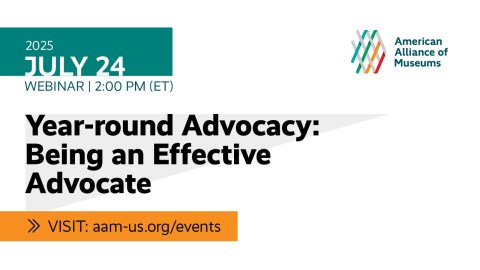Ever wish you had a voice in running the AAM’s annual meeting? Now you do. AAM has opened up the session proposal process to crowdsourced input. You can use the new site to submit a draft session proposal for input from your peers, and to read and comment on the ideas that your colleagues are developing. After the proposals are finalized (Aug. 24), you’ll be invited to vote for the sessions you’d like to see in Baltimore next spring, and the program committee will take your collective opinion into account in making their decisions.
The proposal site’s only been open since Tuesday, and already there are over a dozen proposals available for your inspection. Some of them are nuggets of ideas (“What can museums—particularly smaller institutions—do to raise awareness of their importance and increase support other than dealing with their federal and state officials?”) that will be fleshed out with your input. Some of them are pretty well developed, but could still change if you weigh in with a great idea.
I’ve posted four proposals on behalf of CFM, and would love your help improving them before the voting and formal selection process begins. In addition to introducing crowdsourced input, this year AAM has introduced session formats replacing the traditional default of “three talking heads and a moderator behind a table/podium.” I’ve tried to explore the potential of some of these new formats in shaping the following sessions:
- Ethics Smackdown would pit two speakers (or teams of speakers) against each other to debate a resolution that restrictions on using funds from the sale of collections objects ought to be loosened. CFM’s recent forecast on the future of museum ethics (report currently in prep at the Institute of Museum Ethics) made it clear opinions in the field are split on this topic, with very strong feelings on both sides of the issue. The subject evokes such passion that a knock-down, drag out debate might be just the way to “get it all out on the table.” The audience will be invited to vote on who won the debate, of course.
- One of the new session formats is Creative Collaboration, inviting session organizers to use “role-play, simulation, proto-typing or game play” to explore a topic. I can’t resist trying this format out, so I’ve recruited games designer Ken Eklund (aka “The Writer Guy”) to help me create a futurist approach to the meeting theme of “Storytelling.” We’ll be cooking up some way to explore “Stories of the Future” (known more formally in futures studies as scenarios) through immersive role-play and gaming (details TBD).
- Another great alternative to talking heads is the “Skills Lab” format for hands-on workshops. I’d like to use this to teach a core forecasting skill that I can’t spend much time on in my workshops. How to Read: a Primer on Scanning would lead participants (armed with their own internet connected devices) through the process of selecting and personalizing Web tools for finding, monitoring, bookmarking, archiving and sharing news sources, as well as encouraging attendees share tips on their best sources whether it be mainstream news, obscure online journals, blogs or tweeters. (My not so hidden agenda for this session—I want to recruit and train a cadre of citizen scanners to contribute to CFM’s weekly e-newsletter “Dispatches for Future of Museums.” The more people scanning, the better and more comprehensive the news we compile and distribute to you!)
- Another potential session would feature CFM’s second annual trends report (TrendsWatch 2013) being released next spring. I’m still noodling on how to design a session that adds value to the report itself, rather than just walking people through the content. For now, I’ve proposed using the “Flash” format to feature a series of presenters (one person, with appropriate expertise, for each trend) each giving a lightening summary of one trend and lobbing thought-provoking ideas about potential implication for museums. We ought to provide a way to collect and share audience feedback too—take a look at what I’ve sketched out and see what you think.
If you’re planning to submit a proposal for the 2013 meeting, I strongly encourage you to put your proposal up on the site as soon as possible, and use your own avenues of communication (email, Twitter, blog, word to a friend) to encourage people to read and comment. Whether or not you intend to submit a proposal, please bookmark the site and make a point of visiting, reading and commenting throughout the summer. Let’s get past the days when people exit the session room muttering “I know who would have been PERFECT for that panel, if only they had asked me,” or “it would have been so much cooler if they had done [x].”
Even if a given proposal isn’t selected for Baltimore, your input may help make new connections (as organizers follow up on leads for potential speaker) and inspire people to explore the topic in alternative ways. The site will become a collection of ideas, widely shared and jointly improved, that may inspired videos, podcasts, webcasts and sessions at other meetings, national and local.
Let the crowdsourcing begin!









"How to Read" sounds like an topic that is always useful/interesting to non-futurists!